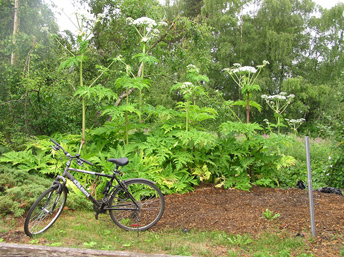Sustainable Development
- Trees
- Ecological Events
- Ecogestures
- Environmental Programs
- The unwanted...
- Environmental Publication
Giant hogweed
A giant plant to avoid!
How to correctly identify the plant
Giant Hogweed
|
Indian Celery or Cow Parsnip
|
|
Plant Height 2 to 4 metres |
Plant Height 2 metres or less |
|
Stem Rigid (5 to 10 cm (2 to 4 in.) in diameter) |
Stem Rigid (5 cm (2 in.) in diameter or more) |
|
Leaves Generally smooth, the leaves can measure up to 1.5m across. The leaf underside is green. Hairs, when present, are stiff and parse. |
Leaves Smaller, the leaves measure up to 50 cm (2.5 ft) across. The underside is generally covered in soft white hairs for a velvety, light green (greyish) appearance. |
For more information
For information on health effects and what to do if you have been in contact with giant hogweed sap, contact Info-Santé (8-1-1).
Other reference sites
Ministère du Développement durable, de l’Environnement et des Parcs
Website: http://www.mddep.gouv.qc.ca/biodiversite/nuisibles/berce-caucase/index.htmWebsite:
http://www.web2.mnr.gov.on.ca/mnr/Biodiversity/Invasive_Species/Giant_Hogweed_Fact_Sheet_F.pdf


